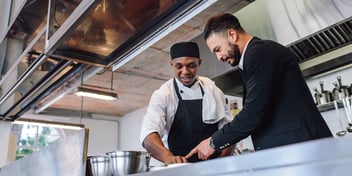
6 Essentials of Efficient Restaurant Operations (w/ Checklist)
If you own or operate a restaurant, you know that understanding the inner workings of restaurant operations is critical. Working with your employees, managing finances, coordinating with vendors, and maximizing profits are just a few of the daily tasks a restaurant operations manager takes on.
At Select Funding, we work with restaurants to provide them with the working capital they need to grow their business. Effective restaurant operations management plays a big role in the success of a restaurant, so we've covered all of the basics in this guide with a handy checklist to stay on top of things.
What are Restaurant Operations?
Restaurant operations consist of the activities necessary to effectively run a restaurant. These include food preparation, customer service, cleaning, purchasing raw materials, accounting, reporting, etc. All these activities at the front of the house and rear combine to form the basis of an effective, profitable restaurant.
Effective restaurant operations are essential to increase profits and provide a positive experience for customers. To manage demand, managers must involve their team and offer new solutions that reduce waste, save cash, and improve ingredients. It's important to keep up with the latest tools and strategies as well as share clear standards and complete lists of tasks. The following six tips can help your restaurant avoid common pitfalls and become a leader in the industry.
#1: An Optimized Restaurant Space
Optimizing your restaurant layout can have a significant impact on how smooth your operation runs. Some changes can even affect the number of customers who come in, how long they stay, and how much they spend.
For example, McDonalds places their restaurant near major roads to tempt passing drivers to eat there. Once you step inside the restaurant, the aggressive colors and uncomfortable seating encourage you to order and eat and leave as efficiently as possible. For these types of restaurants, it’s much more profitable to give quick service and get you to leave than to have you stay and take up space.
It’s not always beneficial to have customers leave quickly, though. For example, if you own a sit-down restaurant, you want to keep your customers comfortable while they dine. This creates a more luxurious dining experience and can encourage customers to spend more, which is more profitable for the restaurant.
These types of changes help with the consumer-facing processes, but there are also changes you can make in the food prep areas that will improve your speed of service. For example, changing your kitchen layout to account for the traffic going through will help your employees move through the restaurant more quickly.
#2: A Dependable Vendor
Finding your vendor may seem simple at first, but when you discover the opportunities that they can offer, you might rethink how you see that price tag. Delivery schedules, on-demand shipments, and reasonable prices are only the surface of a good vendor. Depending on the vendor, you can even negotiate special terms, such as equipment maintenance and even complete replacement. Usually, these types of deals come with a sole vendor agreement, which keeps you from going to several vendors for different shipments.
While it may seem that major vendors are your only option for shipments, there are many independent vendors to choose from. These vendors don’t differ much in quality from their larger counterparts, and can offer a much more personalized experience.
Vendors can also offer samples, which are free-of-charge products to test in your kitchen. This works especially well in environments where the sample can be used in several dishes or as a side. Overall, finding a vendor that can cover you when you need it most is critical to smooth restaurant operations.
#3: Calculated Quality
While it may be tempting to purchase name-brand products exclusively, they’re usually not better than the off-brands. While these name brands can be beneficial to the customer-facing processes, the off-brand products are often manufactured the same way and in the same place as their branded counterparts. This means that you can serve quality food while lowering your overall food cost.
Another quality control factor to consider is pre-prepared food. If you lack staff with strong skills in food preparation, some vendors offer pre-cut meat cuts as a service to reduce the amount of food waste generated. If you decide to purchase pre-prepared food, you should first see if you can get the same thing cheaper when accomplishing the preparation in-house.
The best way to find the lowest price available for products is with this formula:
As purchased price / Edible yield percent = Edible portion cost
This formula determines the actual cost of any food you buy. Because of the different preparation methods of items like veggies and meats, much of what you paid for is lost. This also means that there is less product to profit off. These calculations aren’t just important for finding your best deal, but also for pricing your menu.
Although what you purchase is an important part of quality control, there are also several procedures to follow to ensure food safety. To stay ahead of these requirements and avoid unnecessary costs, you should always:
- Have your staff trained regularly on food safety procedures and keep their certifications up to date
- Check every shipment that comes in for pests
- Ensure that each product matches its product specifications
- Put away everything immediately after it has been thoroughly checked
- Keep up to date with the National Sanitation Foundation and local guidelines, making sure to correct any unsafe practices
#4: A Well-Designed Menu
One of the first things you consider when choosing a restaurant is the menu. That’s why a properly prepared menu is critical to restaurant operations. Menus should use ingredients that are shared between dishes while changing the experience. A great example of this is breakfast restaurants, since eggs can be prepared many different ways (omelet, scrambled, poached, or hard boiled), and also used can be in other dishes (pancakes, waffles, french toast).
It’s also important to consider arrangement when designing your menu. Dishes that are easily prepared and cost more should be a focal point in your menu. Changing where on a menu dishes are placed makes a notable difference in how often they are ordered. Fortunately, most vendors offer services to help you build and design your dream menu.
Properly pricing your menu is another important part of operations. The formula used to calculate your edible portion price is also used for menu pricing. In order to find the ideal pricing for your menu, you have to add the prices of every ingredient in the dish, divide it by the number of portions made, add in a wrap-around cost (usually used to cover the cost of the sides or drinks), and multiply that by the percentage of profit you would like to take.
#5: A Managed Inventory
Inventory can be one of the most complicated aspects of restaurant operations. Generally speaking, your current food inventory should not go over your weekly food cost, your overall inventory should not exceed one percent of your yearly sales revenue, and your food inventory should not go over one-third of your monthly food cost. Maintaining these ratios helps to lower your overall food waste and makes it easier to keep track of your inventory.
It’s very important to keep a sharp eye on your inventory. Unfortunately, there are times when employees will make mistakes when preparing food. You also have to keep an eye on pilferage attempts, especially on high-cost or luxury items. Letting your employees know that you’re keeping track of your inventory helps lower these unnecessary costs.
#6: Happy Employees & Staff
Lastly, and perhaps most importantly, is keeping your staff happy. Many restaurants can fall into the pit of a toxic workplace. Since your employees are the backbone of your operation, it’s important to show them that their work is appreciated. Watching for employees who are stressed or tired and working with them to improve can also help immensely.
Pay raises and appreciation events help encourage employees to work hard, and keeping a positive attitude can lower the amount of mistakes made. You should always give your employees positive reinforcement for their hard work. These little things can add up to a hard-working and reliable staff.
Restaurant Operations Complete Checklist
- Locate areas with traffic and make them easier to navigate
- Make your seating arrangements easy to navigate for both servers and customers
- Find the vendor who can best fill your needs
- Determine the true cost of the food you purchase
- Ensure your profits exceed your purchases
- Certify and train all staff in NSF approved food safety procedure
- Build your safety procedure to exceed what is expected
- Create procedures for properly handling incoming deliveries
- Design your menu to fit your restaurant
- Price your menu according to atmosphere and costs
- Make sure your inventory stays within the amount you expect
- Take care of your staff and keep them happy
Funding Your Restaurant Operations with Small Business Financing
Every restaurant comes with its own costs depending on concept, location, and staff. Finances play a big role in how smoothly a restaurant operation runs, and we hope this guide will help you on your way to ensuring maximum efficiency.
Do you need working capital to take your restaurant business to the next level? From purchasing equipment to funding your menu, we’ve got you covered. Learn more about our restaurant loans and if you qualify here.





